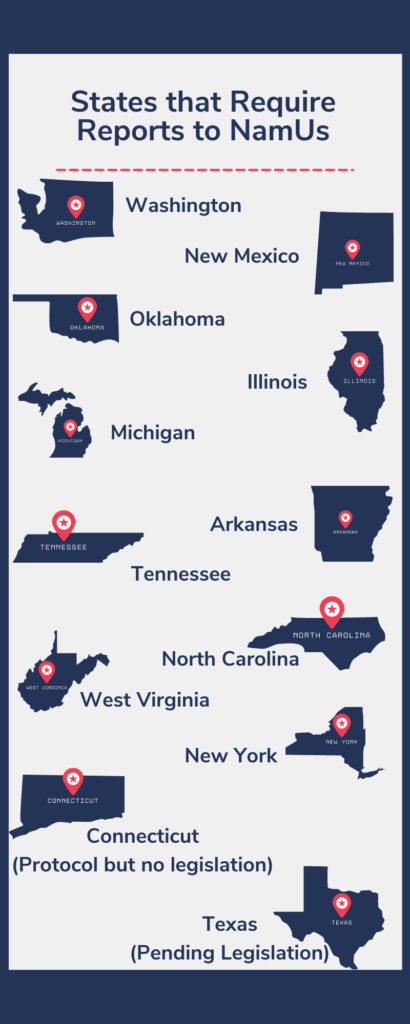
Is NamUS Reporting Required In Your State? Here’s A Look At State Legislation On The Missing & Unidentified Persons Clearinghouse
By Charlotte Spencer
It is estimated that more than 600,000 individuals go missing in the United States every year. While many of those missing are found relatively quickly, thousands disappear, for different reasons, whether by choice or not, for more than a year, becoming, in effect, what investigating agencies often call “cold cases.” Additionally, it is estimated that 4,400 unidentified bodies are recovered each year in the United States, with approximately 1,000 of those remaining unidentified after one year.
If you or your loved one goes missing what happens next, and what resources are used to help you, depends on what state you’re in. Although NamUs is available to all states, its use is not mandated in all states. NamUs stands for the National Missing and Unidentified Persons System. NamUs is a government system created to improve access to information to help solve missing and unidentified persons cases. Created by the Justice Department, it provides technology, forensic, and investigative support. Although NamUs is available for any state or local law enforcement dealing with such cases, not all use it. Most states haven’t mandated reporting local cases to it, but that’s starting to change. A few states passed such laws in 2017, and a handful of states have followed since. So far 10 states have mandated reporting to NamUs. In addition, Connecticut has made it protocol to report to NamUs, although there is no statute requiring this, and Texas is currently considering legislation.
Whether or not you may automatically benefit from NamUs if one of your loved ones goes missing may come down to what state your loved ones live in. It’s important to note, however, that you can still reach out to NamUs even if you don’t live in one of these states. In 2019, NamUs launched its Victim Services Division. Laws like this can still make a difference when a loved one goes missing, though, because they make it more likely that a match to you or your loved one will already be in the system. Further, these laws see to it that missing and unidentified people will be reported into the system even if their loved ones didn’t know about this system. Finally, these laws can help close more cases, thus helping to get murderers off the street before they strike again. Read on to learn if you and your loved ones live in a state mandated to use NamUs.
Federal Law
34 U.S.C. §§ 40501 through 40505 focuses on the reporting of unidentified and missing persons. It includes an authorization of grants for combating the problem of missing and unidentified persons, grant eligibility, use of funds, and reports to Congress on such matters. This section of the law has been amended and added to throughout the years, including recently. Recent updates include the Missing Persons and Unidentified Remains Act of 2019. These laws likely will continue to be updated as technology advances. Federal law does not require local law enforcement to use NamUs services.
New York
In New York NY EXC Law 837 as amended by S6739 requires that missing persons be reported to NamUs within 30 days. In addition, medical examiners and coroners must report unidentified remains to NamUs. As explained in the Justification section of S6739 as written in 2017:
“While the NYS Division of Criminal Justice Services recommends that law enforcement agencies report missing persons to NamUs as well as NCIC, many do not. NamUs reports that a recent review showed 4000 open missing persons cases in the NCIC register, but only 551 in NamUs. This discrepancy in cases show that there is a need to require that missing persons be reported to both databases in order to increase the chances that the missing are found.”
This illustrates why laws like this are so important. Many may expect that it’s unnecessary to mandate behavior which generally everyone agrees is a good idea anyway, expecting that it will be carried out whether or not it’s mandated. As these statistics illustrate, however, such a step often falls through the cracks, especially in jurisdictions where people are juggling large caseloads.
Texas
Texas is currently considering legislation to mandate using NamUs. 2021 TX HB1419, also known as John and Joseph’s Law would require law enforcement to enter all available identifying features of an unidentified body into NamUs. It would also require entering missing persons into NamUs, and NCIC, and if applicable, into the clearinghouse and into the Alzheimer ’s Association Safe Return emergency response center.
Washington
As of June of 2020 Cody’s Law (Washington HB 2792 – 2019-20) has been in effect, after passing unanimously amongst those who voted. When a person has been missing more than 30 days, or when criminal activity is suspected in a missing persons case, the investigating agency must file a report with the Washington State Patrol, collect DNA, and request family consent for retrieving dental records. This information must be forwarded to appropriate labs and the Washington State Patrol. Law enforcement, coroners, or medical examiners must collect identifying information on unidentified human remains and provide this information to the Washington State Patrol. If a person has been missing for more than 30 days, or if criminal activity is suspected in the disappearance, the law enforcement agency must submit this information to NCIC (The National Crime Information Center). Once funded, the Washington Association of Sheriffs and Police Chiefs must regularly transmit information contained within the statewide missing persons website to NamUs. This law also contains details on what must be included in reports depending on the circumstances. Full text of the final bill as passed is available here.

New Mexico
2019 NM HB16, also known as the Mark Daniel Aguilar Information Sharing Requirement, passed unanimously amongst those who voted and was signed and enacted in 2019. It requires the Department of Public Safety to share information with NamUs “as soon as is practicable.” This includes all information in the Missing Persons Information Clearinghouse, and all information the Department receives “pursuant to the Missing Persons Information and Reporting Act regarding the identification and location of missing and unidentified persons or human remains.”
Oklahoma
Okla. Stat. tit. 74 § 151.3. also known as Francine’s Law requires the OSBI (Oklahoma State Bureau of Investigation) to share missing and unidentified persons cases with NamUs. This law also passed unanimously amongst those who voted in 2019. OSBI must share fingerprints, dental reports, DNA information, radiology and medical information, date and place of death, and all other identifying information on unidentified persons if it is available to them. Law enforcement must, within 30 days of a missing persons report, submit a case to NamUs, and any other database required. In addition, they must obtain biometric records of the missing person including medical, dental, and imaging records when possible and submit it to NamUs. They must also submit fingerprints and DNA if possible. They must also report to NamUs when a person previously reported has been found.
Illinois
50 ILCS 722, also known as the Missing Persons Identification Act was recently amended in 2021. Law enforcement must submit details of missing persons to NamUs within 45 days. Under 50 ILCS 722/10 law enforcement must also enter missing person information into the Law Enforcement Agencies Data System (LEADS), the National Crime Information Center (NCIC) databases, the missing person databases of the State DNA Index System (SDIS) and National DNA Index System (NDIS), and use appropriately trained people to enter the details of these reports. They must also follow special procedures for anyone considered a “high-risk missing person.” This law also contains details on what must be included in reports depending on the circumstances.
Michigan
Since 2018 law enforcement must submit records to NamUs as a result of HB 4633. Specifically, law enforcement must report missing persons to NamUs, the law enforcement information network (LEIN), the national crime information center (NCIC), and if the person is a child to the missing child information clearinghouse. This applies if the person is disabled, is a child, is believed incapable of returning without assistance, disappeared during a catastrophe or disaster, disappeared under circumstances that indicated that the disappearance was not voluntary, or disappeared under circumstances that indicated that the person was in danger. If a person has been missing for more than 30 days, law enforcement must seek out and submit dental records of the missing person also. Unidentified bodies must be entered into NamUs, NCIC, and if the body is that of a child, into the clearinghouse. This law also contains details on what must be included in reports depending on the circumstances.
Arkansas
Since 2019, Arkansas law has required law enforcement to enter data into NamUs. All law enforcement must complete training in handling missing and unidentified persons cases. They must submit all missing and unidentified persons cases into NamUs within 30 days including, if available, fingerprints, dental records, descriptions, radiology images, DNA, medical data, and identifying data including date and place of death.
Tennessee
As a result of Tenn. Code 38-6-125, also known as the Help Find the Missing Act, since 2017 forensic centers must enter information on unidentified bodies into NamUs and into the Tennessee Bureau of Investigation. This information must include, if available, fingerprints, dental records, descriptions, DNA, and other identifying information such as date and place of death. Law enforcement must submit missing persons records including dental records and x-rays, if available, to NamUs.
North Carolina
Under NC 143B – 1011 through 1015 law enforcement must immediately upon receiving a missing person report make arrangements to enter data into the national missing persons file, inform all on duty law enforcement, and broadcast to all appropriate agencies to be on the lookout. If the report involves a child they must also notify the National Center for Missing and Exploited Children. Law enforcement must enter information into NamUs if a person has been missing more than 30 days, or a person has been unidentified for more than 30 days. This must include, if available, medical and dental records, and DNA.
West Virginia
Under West Virginia’s Missing Persons Act law enforcement must submit missing persons information if applicable to NCIC, NCMEC, NamUs, CODIS, and the West Virginia Automated Police Network (WEAPON) in a timely manner. Medical Examiners must promptly submit all available information to NamUs and WEAPON for entry into all other appropriate law enforcement databases. This law also contains details on what must be included in reports depending on the circumstances. This law went into effect in 2019.
Connecticut
Although there is no legislation in Connecticut that mandates using NamUs, officials put a statewide protocol in place to use NamUs. See Connecticut Police Officer Standards and Training Policy for Handling Missing Persons Investigations. Missing persons must be entered into NamUs within 30 days. This protocol also contains details on what must be included in reports depending on the circumstances.
This list does not cover the entire content of the laws mentioned above, only the parts relevant to NamUs. For more on the laws in your state follow the links to the original text of the laws provided above. If your state is not on the list above you can still reach out to NamUs or other similar organizations for help. If you live in an area where NamUs is not used, and you would like to encourage your local law enforcement to use it, they may be interested in the bulk data import capability that NamUs is currently developing.
For more stories on missing persons, here are a few selected posts from our archives: